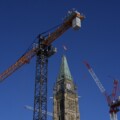Welcome to Need to Know, The Hub’s roundup of experts and insiders providing insights into the economic stories and developments Canadians need to be keeping an eye on this week.
Financial sleight of hand will not actually balance the budget
By Trevor Tombe, professor of economics at the University of Calgary and a research fellow at The School of Public Policy
Last week, Liberal leadership candidate Mark Carney proposed a major shift in how the federal budget is reported. Instead of presenting a consolidated financial picture, he suggests separating operating expenses from capital investments. His rationale remains vague, but he frames it as a way to “spend less and invest more.” The proposal, however, raises serious concerns.
Under current budget rules, capital expenditures—such as infrastructure projects—are already accounted for over time rather than appearing as lump-sum deficits. For example, the government’s $34-billion cost of expanding the TransMountain Pipeline does not immediately impact the federal deficit. Nor should it.
Nothing in how the budget is currently structured prevents a government from making much-needed investment if it wishes. But what it does do is make it more difficult for the public to know what the government’s financial position truly is. A simple question like “What is the deficit?” may become very difficult to answer.
Carney’s call to “spend less” is also ambiguous, but the broader idea of prioritizing investment over excessive government spending is worth considering. Canada has, in recent years, expanded costly income support programs for individuals who are not necessarily in financial distress (i.e., boosting OAS and lowering the eligibility age), while discouraging private investment through heavy regulation and taxation. If Carney intends to reverse these trends, that would be welcome—though his announcement lacked such a clear commitment.
Meanwhile, Conservative leader Pierre Poilievre dismissed Carney’s proposal as “cooking the books,” and history justifies the skepticism. A decade ago, Alberta attempted a similar separation of operating and capital expenses, creating confusion and reducing transparency. The result? A budgeting disaster that obscured the province’s true financial position and weakened public accountability. The actual provincial deficit for the year was effectively hidden. Thankfully this approach was reversed soon after.
Government budgets are already complex enough. Making them more opaque serves no one. If political leaders want to truly encourage investment, they should be applauded. But this goal is achieved only through policy changes—especially by easing regulations and taxes—not financial sleight of hand.
Carney is trying to sell an easy fix to a big problem. Don’t buy it
By Sean Speer, The Hub’s editor-at-large
Over the weekend, Liberal leadership candidate Mark Carney released his fiscal plan to balance the budget in three years.
There’s just one big hitch: Carney proposes to separate the federal government’s operating budget and capital budget. His balanced budget pledge only applies to the former.
It’s part of a broader narrative from his campaign that the government needs to “spend less and investment more” which may be sufficient for a public finance course but prompts various questions in the real world of fiscal policymaking.
Carney’s policy backgrounder commits to backing out transfers to individuals and other orders of government but provides few details about what parts of direct program spending, which at about $230 billion per year is actually greater than transfer payments, will be defined as “spending” and “investment.” The lack of details leaves little doubt that these definitions will be highly elastic and ultimately determined by politics.
The news media should be asking him about whether specific programs are “spending” or “investment” and therefore exempt from his balanced budget pledge. What about pharmacare for instance? Or the Canada Disability Benefit? Or various other Trudeau government initiatives? Is Carney really prepared to cut them or will he just redefine them as investment?
As he inevitably takes more and more spending off the table on the (dubious) grounds that it is really investment, it will become clear that his balanced budget pledge is rather meaningless. It’s the fiscal policy equivalent of claiming a cash-strapped drunk has healthy finances if you only just back out his spending on beer and alcohol.
The lesson of the past ten years is that there are no easy fixes to overcoming the political economy tendency to spend more than incoming revenues. Shuffling expenditures around with loose definitions is merely a more sophisticated version of Prime Minister Trudeau’s faulty notion that “the budget will balance itself.”

New single family houses billed as estate cottages and townhouses under construction are seen in an aerial view, in Delta, B.C., Aug. 12, 2024. Darryl Dyck/The Canadian Press.
One upside to a trade war? Cheaper housing in Canada
By Theo Argitis, managing director at Compass Rose Group
Home sales in Canada fell 3.3 percent in January from a month earlier as the threat of a trade war with the U.S. kept buyers sidelined, the country’s main realtor association said this week.
Meanwhile, new listings surged 11 percent, the most in at least 30 years. James Mabey, chair of the Canadian Real Estate Association, said, “While we continue to anticipate a more active spring for the housing sector, the threat of a trade war with our largest trading partner is a major dark cloud on the horizon.”
Earlier this month, U.S. President Donald Trump imposed 25 percent tariffs on all imports from Canada, excluding energy, which is subject to 10 percent tariffs, set to take effect on March 4. The Bank of Canada estimates that wide-ranging 25 percent tariffs and full retaliation would lower Canadian GDP by 2.5 percentage points in the first year, create large job losses, and increase inflation.
Mabey said the “softer pricing environment” along with lower interest rates are presenting an opportunity for some buyers. The national average home price increased 1.1 percent to $670,100. CREA forecasts a 6.6 percent increase in national home sales this year.
“The market remains on a recovery course with activity running above year-ago levels, but the pace is generally sluggish and uneven,” Robert Hogue, Associate Chief Economist at RBC Economics, wrote in a report. “Buyers may be worried about making big financial decisions amid heightened economic uncertainty.”
“Broad balance” between supply and demand is keeping prices flat and that trend should continue in the coming months, Hogue said, citing January’s 0.1 percent increase from a year earlier in the national composite MLS home price, compared with December’s 0.1 percent decrease.
CREA said the sales-to-new listings ratio of 49.3 percent, compared with a long-term average of 55 percent, indicates “balanced housing market conditions.” The 4.2 months of inventory in January compares with readings in the high threes at the end of last year and a long-term average of five months.
This write-up was originally featured in Means & Ways.









